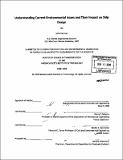Understanding current environmental issues and their impact on ship design
Author(s)
Harman, John (John Michael)
DownloadFull printable version (48.37Mb)
Other Contributors
Massachusetts Institute of Technology. Dept. of Civil and Environmental Engineering.
Advisor
Henry S. Marcus.
Terms of use
Metadata
Show full item recordAbstract
This thesis is intended to provide recommendations for ship owners and operators on how to prepare for new engine emissions regulations that will be progressively more stringent than current regulations. To provide these recommendations, first a general study of current and future international, regional, and local marine emissions regulations was performed. The recent progress of the International Maritime Organization (IMO) was then closely followed. Emissions reduction technologies that could be used to meet the proposed IMO emissions standards were analyzed. Special consideration was given to the effects that these technologies have on ship design and ship operation. It is expected that the MEPC-proposed Tier II and Tier III regulations discussed within this thesis will set the standard for marine emissions from large diesel engines well into the future. Ship owners should plan to meet these standards while remaining conscious of regional emissions regulations that may be even more stringent. The technologies that ship owners use to meet these standards should be selected while bearing in mind the impact on fuel oil consumption and CO2 emissions; IMO's next step is to develop marine emissions regulations to address CO2 emissions. Specific recommendations for complying with future marine emissions regulations are provided.
Description
Thesis (S.M.)--Massachusetts Institute of Technology, Dept. of Civil and Environmental Engineering, 2008. Includes bibliographical references (leaves 160-164).
Date issued
2008Department
Massachusetts Institute of Technology. Department of Civil and Environmental EngineeringPublisher
Massachusetts Institute of Technology
Keywords
Civil and Environmental Engineering.